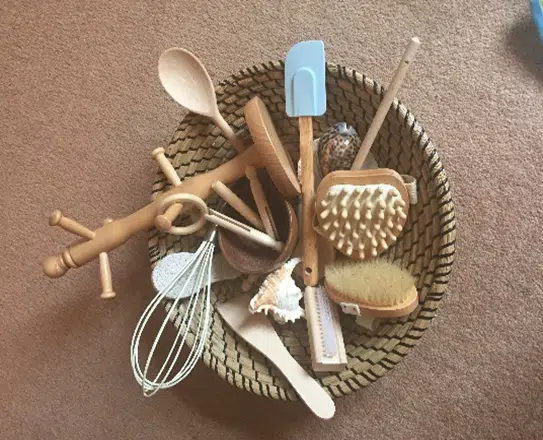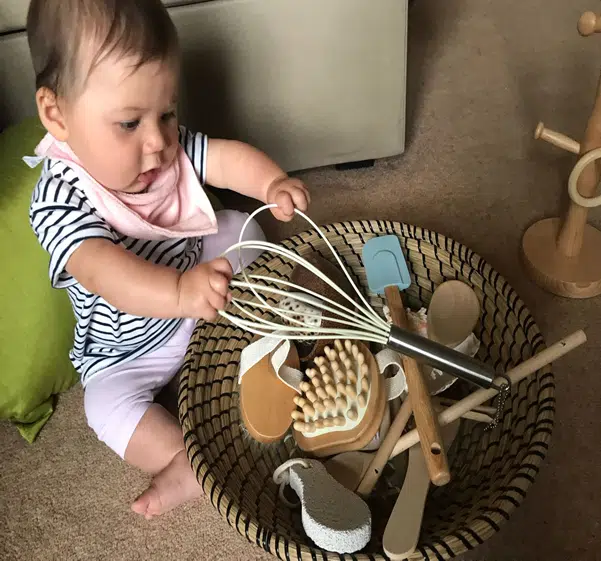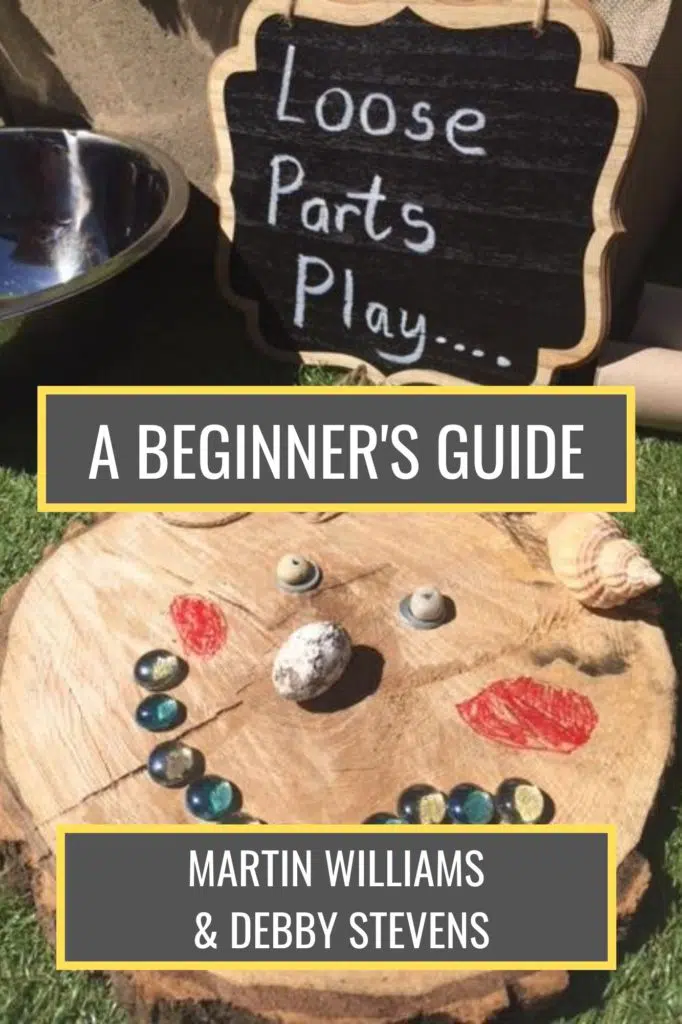Often the simplest things in play can be the best, and playing with treasure baskets is something that babies seem to find so enjoyable and get amazingly engrossed in. But have you ever wondered what they are actually learning? What are the benefits of using treasure baskets with babies?
There are many benefits of using treasure baskets, including they are an excellent resource to stimulate curiosity, concentration and a sense of independence.
There are many other benefits, and I am going to list what I believe to be the 16 most important ones, and explain a little about each. It is incredible that such a simple system of play can provide so many positives.

What Are Treasure Baskets?
Just so you are definitely sure before I go onto the benefits, treasure baskets are shallow containers that contain a range of random objects. The baskets are often made of wicker or something similar.
The objects that you put into the basket are normally everyday items, often selected for their properties and characteristics. For example, you will often find some of the following in a treasure basket: metal cooking utensils, brushes, shells, pine cones, wooden items, and feathers.
You can check out my essential guide on what treasure baskets are and how to use them here.
When To Use Them?
Treasure baskets can be used with babies when they are able to sit up, either by themselves or with support.
Treasure baskets provide an independent form of play, where children are allowed to investigate and examine the objects in the basket and use them however they like. The role of the adult is to facilitate rather than teach.
Treasure baskets can be used just as well either in an educational setting like a nursery, or at home. The process is the same.
This article is designed just as much for parents as for educators. Treasure basket play is the most important type of loose parts play for babies.
Right, now you definitely know what they are, let’s have a look at the numerous benefits.

The Benefits
1.Curiosity
This is one of the key skills of life itself. Psychologists link the trait of curiosity to an enhanced chance of being happier in later life. If you are interested and curious about the world around you, you are much more likely to have a sense of happiness and peace.
Curiosity is also one of the central motivators for learning. To stimulate a child’s curiosity is to open their senses to the world around them, and starting them thinking about everything they encounter.
We recommend curiosity as the primary motivator in our online course and mastermind community, Project Loose Parts. This program walks you through how to set up an outstanding culture of loose parts in your school or preschool. We have members from around the world, and you can check out our Project Loose Parts Program here.
The mixture of textures, shapes and feelings of the objects in treasure baskets stimulates this curiosity.
2.Decision Making
When babies play with treasure baskets, it is recommended that the adult does not intervene in their play unless essential. One of the reasons behind this is to foster their decision-making processes.
The children are in control when they play. The decide which item to pick up from a selection of choices. They decide what they will do with it.
It is a process of becoming autonomous, and understanding they have control over their surroundings.
-40 Fantastic Loose Parts Play Activities
-21 Benefits of Risky Play With Examples
3.Practise Sitting
It is amazing the length of time that babies will sometimes engage with treasure basket play. Whilst being fully involved mentally and through their senses, this time will also be excellent practice for them in sitting up.
They will be strengthening their core, and many other muscle groups, as well as developing balance and coordination.
4.Gross Motor
Their curiosity and excitement about the objects will be motivating their bodies to touch and manipulate and explore.
Treasure baskets offer an excellent platform for developing physical skills, and gross motor movements in the arms. They also are a starting point for fine motor skills, as children will be using their hands and fingers to hold, touch and explore.
5.Experimenting
When fully engrossed in treasure basket play, babies are like scientists.
They select objects and experiment with them. They test their feel, their structure, their texture.
They create theories about reality, and test their theories. To find out the 16 best loose parts play activities for science then check out this article.
6.Independence
Independence is a huge part of open-ended play such as treasure baskets.
Again, this is one of the key skills of life. Many people value their sense of independence as one of the most important things in their lives, and this feeling of being in charge of our own lives must start somewhere.
In treasure baskets play, the children are in charge.
They are the decision maker.
They are in charge of their own learning.
They are free to manipulate the materials however they feel and to find out whatever they can from the experience.
7.Begin To Understand Mathematical Properties Of Objects
Treasure baskets offer some starting points for beginning to think about objects in a mathematical way.
For example, they will be experiencing the different weights of objects, and how some are heavier, others lighter.
They will find out that some things are longer, some shorter.
They may experience rolling, or turning, bending, folding, and many other physical properties of materials.
Children begin their experience with mathematics by interacting with simple and cheap objects in their environment. I have written a free ebook called ’50 Outdoor Number Activities on a Budget’ that you can download here if you’re searching for inspiration on a budget.
8.Total Involvement
In the sporting arena, the phrase ‘getting in the zone’ is often used. It is the state were individuals are fully focussed on what is happening.
They are alive in the present, and fully attending on what is happening at a given moment.
Children will often be seen to get into this zone during their play. This is a beautiful and natural state that is the zenith of learning.
Treasure baskets can often provide this state of total involvement. Children get fully engaged in the objects and in manipulating them, and have no other thoughts than the items as they feel and examine them.
Total involvement is a key feature of all our online courses, whether they are on literacy, loose parts, the outdoors, and all the other topics we have covered.
9.Begin To Choose Likes/Dislikes
This is again linked to decision making.
Babies will often really like some objects in a treasure basket, and seem to not like other objects so much.
It is a good idea to often repeat treasure basket play regularly, and these likes/dislikes will often become clearer as they use the same objects again.
One child will really like a leather glove, but not be interested in the shells. Another will like a wooden spoon, but have no interest in a lemon.
No one can really say why they like one thing and reject another. It is all down to personal preference. This is a good skill to take forward into life, however, as we are all of us faced with choosing those things we like and those we don’t.
10.Learning Through Feel
Babies are very kinaesthetic in their learning style, and receive a huge amount of information through touch things both with their hands and their mouths.
Treasure baskets provide the perfect outlet to focus this sensory learning, and to help them develop.
11.Develop Concentration
Treasure basket play is an excellent way of developing the child’s concentration and attention span.
They provide a means of focussing their attention, and lead them to remain focussed on one train of thought over a prolonged time.
I have heard a few parents remark about how amazed they were when their child has been totally engrossed in a treasure basket for 40 or 50 minutes. It seems amazing that they are capable of this level of attention.
12.They Are Multisensory
In treasure basket play, children are involved with all of their senses.
For example, they use sight to examine colour, size, shape and textures of objects.
They can smell some objects, particularly if you include objects such as leather, fruits such as limes, or natural wooden objects.
Babies will usually interact with objects with their mouths to learn more about them, and this will activate both smell and taste.
Noisy objects can be added to treasure baskets to stimulate their sense of hearing. Examples could be squeaky dog toys, bells, or objects in a glass jar.
The sense of touch has a huge part to play in treasure basket play, and children are continually touching, stroking, picking up and dropping objects.
13.Simple To Facilitate And Resource
This is more a benefit for the adults, rather than the children!
Treasure baskets are at worst either extremely cheap, or at best completely free.
The only part that might require a bit of an investment is the basket itself, but these are certainly not going to break the bank.
The rest of the treasure basket experience just requires you to find some random objects around your house, or beg, steal or borrow some from friends, family or colleagues.
14.Develop Their Eyesight
With their curiosity heightened, children are interested to examine objects with their eyes. This helps their eyes focus, and practices looking intently at close and medium ranges over an extended period.
Hands and eyes work together, both strengthening the effect and skills of the other.
15.Brain Development
Researchers have found significant evidence that treasure baskets provide a wealth of brain development opportunities.
This is probably not surprising, when you think about the level of concentration, thinking and curiosity that they generate.
16. Introduction To Loose Parts Play
Treasure baskets are normally used between the age of about 6 months to when a child can walk. Following that the play will usually develop into heuristic play which is quite similar to treasure basket learning. Following that, the children will engage in more complex forms of loose parts play when they are slightly older again.
It is great that treasure baskets are part of a continuum. They feed into heuristic play, that in turns develops into loose parts in more complex forms.
Many of the skills that the children are starting to develop during treasure basket play can be expanded and deepened through their later experiences.
Top Tips To Get The Very Best Out Of Treasure Baskets
Treasure baskets play is certainly not a complicated or difficult form of learning. Quite the opposite!
However, it does pay to follow a few simple guidelines and pointers. Do these, and you will be completely fine…
- Try and find a reasonably good-quality wicker basket. Ideally one that is quite resilient is what you need. Also high quality baskets are very aesthetically interesting and pleasing on the senses
- Look for a basket that is very shallow and round to enable babies to reach inside easily
- Be aware of safety. You only want to put objects into it that are safe. There are a few things to be mindful. Most importantly, don’t put in anything too small that they might put into their mouths. Also nothing that has small parts that can removed. One other thing to think about is watching out for anything they might get their fingers stuck in, such as a narrow whisk.
- Select objects based on their ‘heuristic’ properties. This basically means a selection of different sizes, textures, materials, and shapes. If you’re interested to see the kinds of materials that are used in loose parts play then check out at least 100 ideas here.
Items You Could Use To Create A Treasure Basket Today
If you haven’t already created a treasure basket, you can definitely simply get started today. You will be able to find numerous objects around your home or educational setting that will work really well.
Some good examples of objects include:
- Nail brush
- Sponges
- Balls of different sizes
- Wooden spoons
- Fir cone
- Whisks
- Fleece
- Leather glove
- Rubber tubes
- Brushes
- Seashell
- Metal cooking utensils
- Leather items
- Natural objects
- Sensory materials
- Wooden items
- A variety of measuring cups
- Large feathers
- Wool pom-poms
- Keys
I have also created the essential guide to treasure basket ideas that you can look at here. This contains a huge number of ideas for objects that you can include in a treasure basket.
The Next Level
If you are interested in getting started successfully with loose parts play for babies and toddlers, then check out my book ‘Loose Parts Play – A Beginner’s Guide.’ This walks through the key points in how to get started successfully with loose parts, and how to avoid all the pitfalls. You can check it out on Amazon here.

Conclusion
Treasure baskets are so simple, and yet so multi-faceted. There are so many positives that the children that utilise them will experience.
Also, like many of the best things in life, they are either free, or at least cheap.
If you’ve never yet taken the plunge of having a go of using a treasure basket, then I recommend getting started today.
What Next?
If you are reading this and live in the UK, you might want to check out our Loose Parts Play practical training course that we run at venues throughout England and Wales. This is open to both parents and educators. Here is a link to a description of that course.
This article is in part an extract from the book ‘Loose Parts Play – A Beginner’s Guide’ written by myself and my colleague Debby Stevens. This book provides a full, yet simple guide to setting up an outstanding loose parts culture in your home or educational setting with children aged 0-5.
